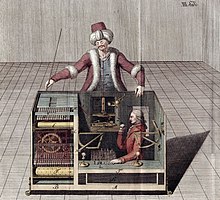
The Mechanical Turk, also known as the Automaton Chess Player (German: Schachtürke, lit. 'chess Turk'; Hungarian: A Török), or simply The Turk, was a fraudulent chess-playing machine constructed in 1770, which appeared to be able to play a strong game of chess against a human opponent. For 84 years, it was exhibited on tours by various owners as an automaton. The machine survived and continued giving occasional exhibitions until 1854, when a fire swept through the museum where it was kept, destroying the machine. Afterwards, articles were published by a son of the machine's owner revealing its secrets to the public: that it was an elaborate hoax, suspected by some, but never proven in public while it still existed.[2]
Constructed and unveiled in 1770 by Wolfgang von Kempelen (1734–1804) to impress Empress Maria Theresa of Austria, the mechanism appeared to be able to play a strong game of chess against a human opponent, as well as perform the knight's tour, a puzzle that requires the player to move a knight to occupy every square of a chessboard exactly once.
The Turk was in fact a mechanical illusion that allowed a human chess master hiding inside to operate the machine. With a skilled operator, the Turk won most of the games played during its demonstrations around Europe and the Americas for nearly 84 years, playing and defeating many challengers including statesmen such as Napoleon Bonaparte and Benjamin Franklin. The device was later purchased in 1804 and exhibited by Johann Nepomuk Mälzel. The chessmasters who secretly operated it included Johann Allgaier, Boncourt, Aaron Alexandre, William Lewis, Jacques Mouret, and William Schlumberger, but the operators within the mechanism during Kempelen's original tour remain unknown.